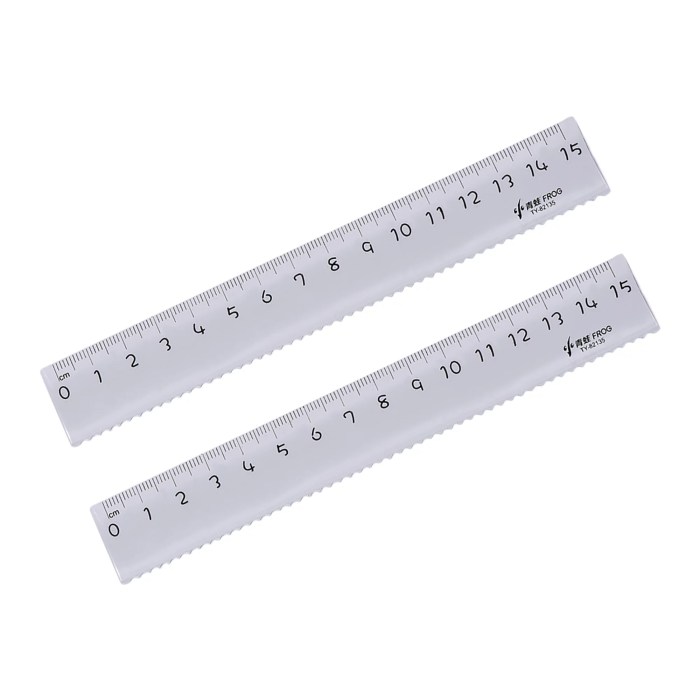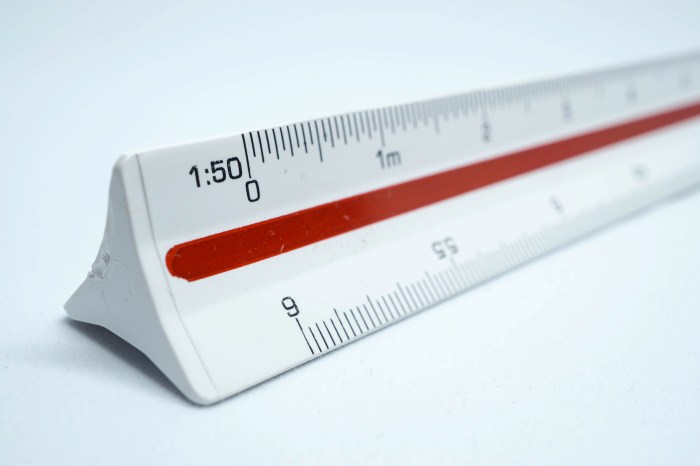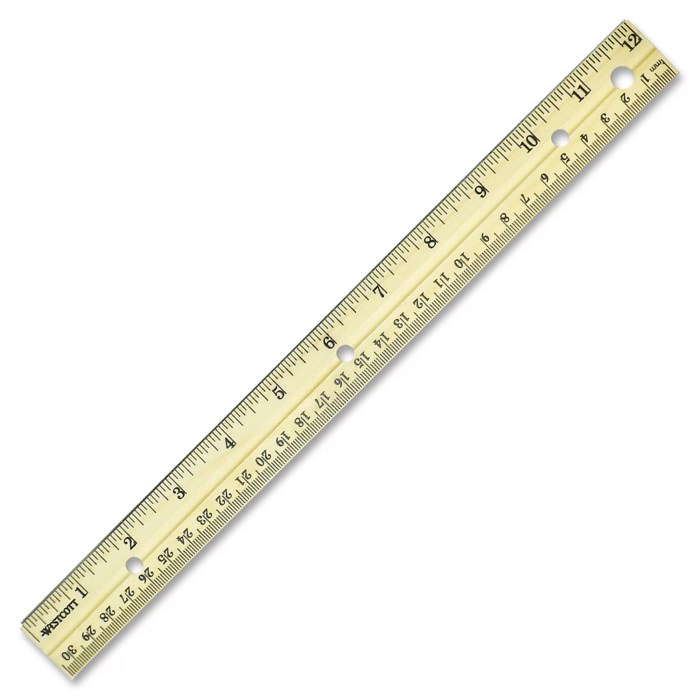Metric ruler units for short – Introducing metric ruler units, a standardized system of measurement that simplifies communication and ensures accuracy across various fields. From scientific research to everyday tasks, these units play a crucial role in quantifying our world.
This guide delves into the intricacies of metric ruler units, providing a comprehensive overview of their usage, conversions, and applications.
Introduction to Metric Ruler Units

Metric ruler units are a system of standardized units used for measuring length. They are based on the meter, which is defined as the distance traveled by light in a vacuum in 1/299,792,458 of a second.The metric system is important because it provides a common language for scientists and engineers around the world.
It allows them to communicate and compare their measurements accurately and consistently.
Advantages of Using Standardized Units
There are several advantages to using standardized units:* They allow for accurate and consistent communication.
- They facilitate comparison of measurements made by different people or at different times.
- They help to avoid errors that can occur when using different units of measurement.
- They make it easier to convert between different units of measurement.
Common Metric Ruler Units

Metric rulers are essential measuring tools that use the metric system, a standardized system of measurement based on the decimal system. Metric rulers are widely used in scientific, engineering, and everyday applications.
The most common metric ruler units are millimeters (mm), centimeters (cm), and meters (m). These units are related by the following conversion factors:
Conversion Factors
- 1 meter (m) = 100 centimeters (cm)
- 1 centimeter (cm) = 10 millimeters (mm)
Common Metric Ruler Units
The table below shows the most common metric ruler units, their abbreviations, and their equivalents in other units:
| Unit | Abbreviation | Equivalent in Other Units |
|---|---|---|
| Meter | m | 100 centimeters, 1000 millimeters |
| Centimeter | cm | 10 millimeters |
| Millimeter | mm | 0.1 centimeter |
Converting Between Metric Ruler Units
Converting between different metric ruler units is a straightforward process that involves multiplying or dividing the original measurement by a specific conversion factor. The conversion factors are based on the relationship between the different units.
Converting Larger to Smaller Units
To convert from a larger unit to a smaller unit, multiply the original measurement by the appropriate conversion factor. For example, to convert from centimeters to millimeters, multiply by 10 (since there are 10 millimeters in 1 centimeter).
- 1 centimeter (cm) = 10 millimeters (mm)
- Conversion factor: 10 mm / 1 cm
- Example: 5 cm = 5 cm – 10 mm/1 cm = 50 mm
Converting Smaller to Larger Units
To convert from a smaller unit to a larger unit, divide the original measurement by the appropriate conversion factor. For example, to convert from millimeters to centimeters, divide by 10 (since there are 10 millimeters in 1 centimeter).
Metric rulers use simple units like centimeters and millimeters to measure short lengths. Even the most complicated scientific equipment uses metric units. For example, Naomi Klein’s book “Let Them Drown” describes the devastating impact of climate change on coastal communities, using metric units to quantify the rising sea levels.
- 1 centimeter (cm) = 10 millimeters (mm)
- Conversion factor: 1 cm / 10 mm
- Example: 50 mm = 50 mm / 10 mm/1 cm = 5 cm
Measuring with Metric Ruler Units

Using a metric ruler correctly is crucial for obtaining precise measurements. Let’s delve into the proper technique and the significance of accurate measurements.
Proper Technique
To use a metric ruler effectively:
- Align the zero mark of the ruler with the starting point of the object you’re measuring.
- Read the measurement at the point where the end of the object aligns with a ruler marking.
- Estimate to the nearest millimeter (mm) or centimeter (cm) for greater accuracy.
Importance of Accurate Measurements
Accurate measurements are essential in various fields, including science, engineering, and everyday tasks. Precise measurements:
- Ensure consistent and reliable results in experiments and calculations.
- Enable precise construction and assembly of objects.
- Help us understand and quantify the physical world around us.
Applications of Metric Ruler Units

Metric ruler units are extensively used in various fields, from scientific research to everyday life. Their precision and consistency make them the preferred system of measurement in many industries.
Science
In science, metric ruler units are crucial for accurate measurements in experiments and observations. They are used to measure the length of specimens, distances between objects, and other physical dimensions. In fields such as biology, chemistry, and physics, metric units ensure precise and reproducible results.
Engineering
Metric ruler units are essential in engineering for designing and constructing structures, machines, and devices. Engineers rely on precise measurements to ensure the accuracy and safety of their creations. From measuring the dimensions of components to determining the distance between parts, metric units facilitate precise calculations and ensure proper functioning.
Everyday Life, Metric ruler units for short
Metric ruler units are ubiquitous in everyday life. We use them to measure the length of fabric, furniture, and other household items. They help us determine the size of objects, distances, and quantities. From measuring the height of a child to determining the amount of ingredients in a recipe, metric units provide a standardized and convenient way to make measurements.
Advantages and Disadvantages of Metric Ruler Units: Metric Ruler Units For Short

The metric system, based on the meter, is a decimal system of measurement that is widely used around the world. Metric ruler units, such as centimeters and millimeters, are commonly used for precise measurements in various fields, including science, engineering, and manufacturing.
Like any measurement system, metric ruler units have both advantages and disadvantages. Let’s explore them in more detail:
Advantages
- Simplicity and Consistency:The metric system is based on the decimal system, making it easy to perform calculations and conversions. The units are all related by powers of 10, which simplifies the process of scaling up or down.
- International Standard:Metric units are recognized and used worldwide, facilitating communication and collaboration across borders. This standardization eliminates the need for conversions when sharing measurements or comparing data.
- Precision and Accuracy:Metric units, particularly millimeters and micrometers, allow for highly precise measurements. This precision is crucial in fields such as engineering, scientific research, and manufacturing, where accuracy is paramount.
- Logical Progression:The metric system follows a logical progression of units, with each unit being 10 times larger or smaller than the next. This makes it easy to understand and visualize the relationships between different units.
Disadvantages
- Not Universally Adopted:While metric units are widely used, some countries, such as the United States and the United Kingdom, still use imperial units as their primary measurement system. This can lead to confusion and errors when working with international collaborators or comparing data.
- Learning Curve:For individuals who are not familiar with the metric system, there may be a learning curve involved in understanding and using the units. However, with practice and familiarity, this becomes less of an issue.
- Conversion Challenges:When working with imperial units, it may be necessary to convert measurements to metric units or vice versa. This can be time-consuming and prone to errors, especially for complex calculations.
Future of Metric Ruler Units

The future of metric ruler units looks promising, with continued adoption and advancements expected in various fields.
Potential Advancements
The metric system is undergoing continuous refinement and expansion, with new units and standards being developed to meet evolving measurement needs. For example, the International System of Units (SI) has recently introduced the “atto” prefix, representing one-quintillionth (10^-18) of a unit, for use in quantum physics and other specialized fields.
Technological advancements are also driving the adoption of metric ruler units. Laser-based measurement devices and digital calipers offer precise and convenient measurements, making metric units more accessible and practical in various applications.
Changes in Use
As the world becomes increasingly interconnected, the metric system is gaining widespread acceptance as a global standard for measurement. This trend is expected to continue, with more countries adopting the metric system for trade, scientific research, and everyday use.
In the United States, which is one of the few countries that still primarily uses the imperial system, there is a growing movement towards metrication. Many industries, such as healthcare and manufacturing, have already adopted the metric system for efficiency and compatibility with international standards.
Expert Answers
What are the advantages of using metric ruler units?
Metric ruler units are standardized, easy to convert, and widely accepted, making them convenient and reliable for various applications.
How do I convert between different metric ruler units?
Converting between metric ruler units involves multiplying or dividing by powers of 10. For example, to convert millimeters to centimeters, divide by 10.
What are some common applications of metric ruler units?
Metric ruler units are used in scientific research, engineering, manufacturing, medicine, and everyday activities like measuring ingredients in cooking or determining the length of fabric.